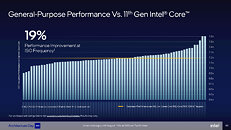- Joined
- Oct 9, 2007
- Messages
- 47,291 (7.53/day)
- Location
- Hyderabad, India
| System Name | RBMK-1000 |
|---|---|
| Processor | AMD Ryzen 7 5700G |
| Motherboard | ASUS ROG Strix B450-E Gaming |
| Cooling | DeepCool Gammax L240 V2 |
| Memory | 2x 8GB G.Skill Sniper X |
| Video Card(s) | Palit GeForce RTX 2080 SUPER GameRock |
| Storage | Western Digital Black NVMe 512GB |
| Display(s) | BenQ 1440p 60 Hz 27-inch |
| Case | Corsair Carbide 100R |
| Audio Device(s) | ASUS SupremeFX S1220A |
| Power Supply | Cooler Master MWE Gold 650W |
| Mouse | ASUS ROG Strix Impact |
| Keyboard | Gamdias Hermes E2 |
| Software | Windows 11 Pro |
The 8 "Golden Cove" performance cores (P-cores) present on 12th Gen "Alder Lake-S" desktop processors offer an IPC gain of 19% over the "Cypress Cove" cores powering current 11th Gen "Rocket Lake-S" processors, claims Intel. This would put them at roughly 35% higher IPC than the "Skylake" cores that powered Intel client desktop processors until as recently as 2020, with the 10th Gen "Comet Lake." This 19% number, however, is presented as a geomean of performance improvement at iso-frequency, across a wide selection of tests that include SPEC CPU 2017, SYSmark 25, Crossmark, PCMark 10, WebXPRT3, and Geekbench 5.4.1.
The high IPC of the P-cores, coupled with the high rumored frequencies for the enthusiast i9-12900K part running well into 5.30 GHz or beyond, begins to explain how 8 of these "Golden Cove" cores, coupled with 8 fairly fast "Gracemont" cores, closes in on the 16-core AMD Ryzen 9 5950X at Cinebench R20.


The "Golden Cove" performance core achieves this 19% IPC gain over its desktop predecessor by being "wider, deeper, and smarter." Any x86 core includes three basic components, the front-end, the execution stage, and the load/store stage. The front-end of "Golden Cove" sees a double-sized instruction-TLB, a "smarter" branch predictor; and double-wide decode unit. There are numerical increments to the decode unit, micro-op queue, and micro-op cache. The out-of-order (OoO) engine sees similar increments, with 6-wide allocation and 12-wide execution ports, compared to 5-wide and 10-wide for "Cypress Cove," respectively. The execution stage sees the addition of a 5th execution port and ALU; FMAs with FP16 support; and an updated FADD (fast adder). Similar improvements are made to the cache and memory sub-system. 1.25 MB is the size of the dedicated L2 cache for client versions of "Golden Cove," and 2 MB for server/HEDT versions.






View at TechPowerUp Main Site
The high IPC of the P-cores, coupled with the high rumored frequencies for the enthusiast i9-12900K part running well into 5.30 GHz or beyond, begins to explain how 8 of these "Golden Cove" cores, coupled with 8 fairly fast "Gracemont" cores, closes in on the 16-core AMD Ryzen 9 5950X at Cinebench R20.


The "Golden Cove" performance core achieves this 19% IPC gain over its desktop predecessor by being "wider, deeper, and smarter." Any x86 core includes three basic components, the front-end, the execution stage, and the load/store stage. The front-end of "Golden Cove" sees a double-sized instruction-TLB, a "smarter" branch predictor; and double-wide decode unit. There are numerical increments to the decode unit, micro-op queue, and micro-op cache. The out-of-order (OoO) engine sees similar increments, with 6-wide allocation and 12-wide execution ports, compared to 5-wide and 10-wide for "Cypress Cove," respectively. The execution stage sees the addition of a 5th execution port and ALU; FMAs with FP16 support; and an updated FADD (fast adder). Similar improvements are made to the cache and memory sub-system. 1.25 MB is the size of the dedicated L2 cache for client versions of "Golden Cove," and 2 MB for server/HEDT versions.






View at TechPowerUp Main Site




